Built in 1902, Alice is the sister engine to Holy War (No. 779). She worked at Dinorwic until about 1960. She was then used for spare parts at the quarry and purchased as a source of spare parts by the then owner of Holy War.
In 1977 the remaining parts were gathered together at the Bala Lake Railway and in 1987 these remains were purchased by BLR volunteer worker Chris Scott & work started on restoration. The remains were later moved to the owner's garage, the Ffestiniog Railway and onto the Leighton Buzzard Railway who agreed to finance the new boiler.
Alice returned to steam in 1994, having been rebuilt in the style of quarry locomotives - cabless and with dumb buffers made from large lumps of timber. The locomotive moved back to the Bala Lake Railway in 2003.
Alice was purchased in 2010 by Julian Birley.
Specifications and dimensions
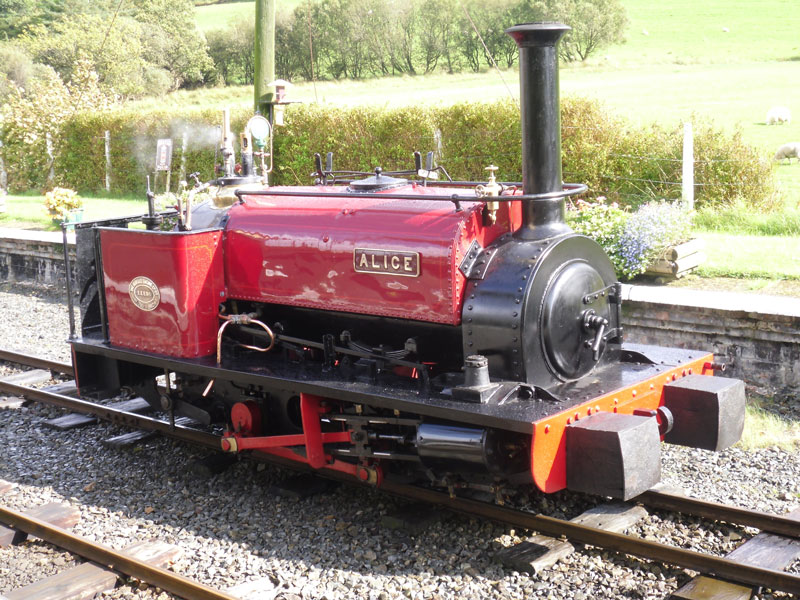
Class name Alice (Dinorwic) Date Built 1902 Size of cylinders x stroke 7in x 10in Diam. Of coupled wheels 1ft 8in Rigid wheelbase 3ft 3ins Overall length 13ft Overall width 5ft 4ins Overall height (rail to top of chimney) 7ft 3ins Heating surfaces - small tubes 86 sq ft Heating surfaces – firebox 14 sq ft Total heating surface 100 sq ft Grate area 2.5 sq ft Working pressure 140 psi Tank capacity 100 galls Fuel space – Coal 1.5 cwt Weight Empty 5 Tons 10 cwt Weight in working order 6 Tons 0 cwt Tractive effort at 75% boiler pressure 2,578lb
History
Originally named No 4, the engine was rechristened "Alice" soon after arrival at Dinorwic Quarry in 1902. Confusion must be avoided as this Alice was named after Louisa Alice Duff (b.1853 d.1926), daughter of Mary and George Duff and married to Lord Hussey 3rd Baron Vivian 8 June 1876. Coincidentally she was to become the mother-in-law of Field Marshall Sir Douglas Haig. She was sister in law to Laura Alice Jones, who married George William Duff in 1888 heir to the title and after who locomotive 492 of 1899 was named and then later renamed "King of the Scarlets". Louisa Alice had already lent her first name to Locomotive number 195 of 1877 and when this was sold to the Lower Glynrhonwy Quarry on the opposite side of Lyn Padarn to the Dinorwic Quarry the name went with her. So on delivery of loco 780 her second name, Alice, was used.
The locomotive was supplied to Dinorwic Quarry in May 1902 at a cost of £550 along with loco no. 779 "Holy War". Hunslet order number: 24820.

Driver: Jack Davies. His nickname in the quarry was Sion Marged (Welsh for John the son of Margaret). Clifford Davies fireman. c1950
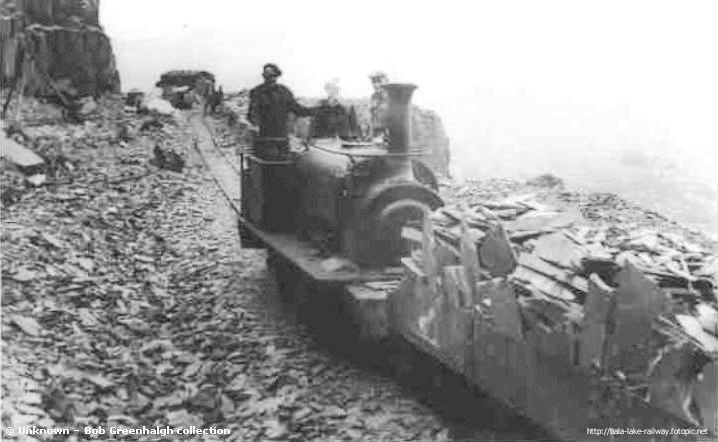
Driver: Jack Davies

From the time she was delivered in 1902 the first gallery she worked on was Dyffryn and was there until 1914. From there she was moved to California level where she worked until 1929 before moving to Bonc Moses. She stayed on this gallery until 1945 when she was moved again up high to Australia level, 1800 feet above sea level, and here she stayed for the rest of her working life and was recorded as being out of service in 1960. An entry in the Dinorwic records dated 27th September 1960 states that she had been used on a ‘casual basis’ for four or five months. This probably means that she was employed to recover equipment on the now closed level. There were no further entries as she was progressively plundered for spares for other engines. By September 1967 she was effectively abandoned in her shed on Australia Level.
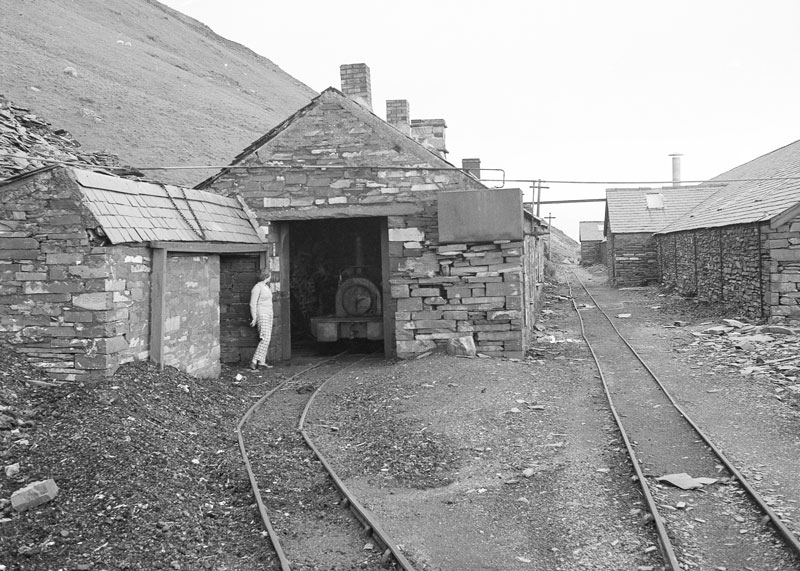
Photo: Trevor Cousins
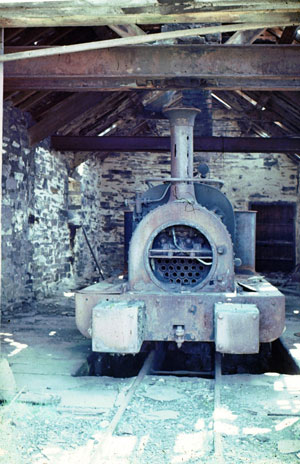

Photos: Michael Bishop and Trevor Cousins
Her mortal remains were purchased by John Marshfield-Hutchings on 6th January 1969 as a source of spares. The wheels, under parts and boiler fittings were removed and taken to Quainton Road, Buckinghamshire, along with "Holy War", also owned by Mr. Marshfield Hutchings. In 1975 "Holy War" and "Alice"’s parts were purchased by the Revd Alan Cliff, Vice-President of the Bala Lake Railway Society and taken to the line's HQ at Llanuwchllyn for leasing to that railway.
The depleted remains of the engine stayed in the remote Quarry shed and to many "Alice" was now regarded simply as scrap. At least two potential purchasers had already looked at the possibility of recovering her. In one case permission was refused by the directors of the quarry on safety grounds. The other scheme would have been quite spectacular, involving the RAF affecting a rescue using a Chinook helicopter but, although initially keen, the fear of under currents close to the face of the mountain led to the decision not to undertake the operation. Despite the problems of being so remote and so high up on the mountain members of the West Lancashire Railway purchased what was left, with a view to providing a boiler for their locomotive "Irish Mail" (823 of 1903). In 1972 "Alice" was lowered down the derelict C incline, a huge operation which took a number of months to complete. She was then taken to Hesketh Bank near Preston in Lancashire. The boiler was removed and, after the acquisition of the original fittings from Mr. Marshfield-Hutchings, was restored and fitted to "Irish Mail".
In 1977 the even more depleted mortal remains, now in the ownership of George Barnes were all reunited at the Bala Lake Railway where he was the General Manager and Chief Engineer - joining the parts now owned by Alan Cliff.
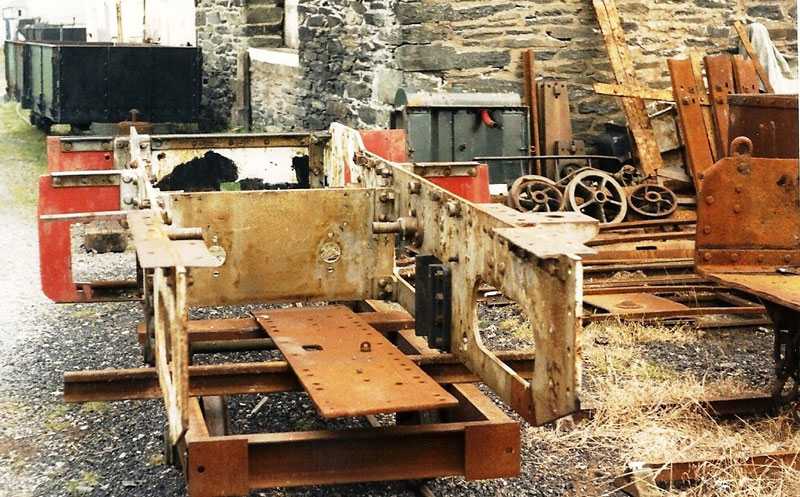
Photo: Chris Scott
Little work was done immediately, although various plans were discussed which involved converting her into an 0-4-2 side tank tender engine!
With no firm decision made and the running of the railway taking priority work was largely only done by volunteers. In the summer of 1980 a certain amount of preparatory work was done to the frames including cleaning them up and removing and straightening the rear buffer beam. They were then covered with coats of protective primer and aluminium paint.

Photo: Chris Scott
Several other parts were taken away from Llanuwchllyn for cleaning and reconditioning, returning neatly wrapped in polythene.
Around this time the top of the water tank was cut away to provide access and the rusted sections removed.
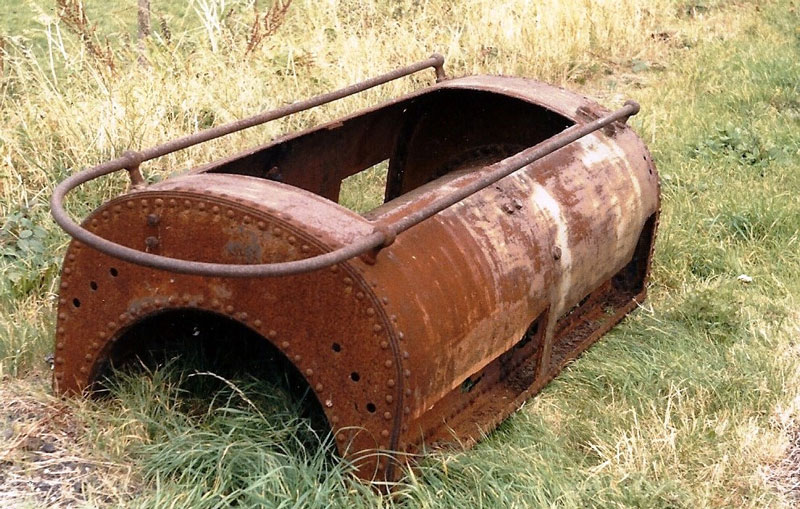
Photo: Chris Scott
The wheels had been sent to the Talyllyn some four years previously, and some surprise was apparently occasioned at Tywyn when the works were asked to re gauge them. Little further work was carried out and with the rebuild of "Maid Marian" taking much longer than anticipated, other priorities took precedence, including the arrival of no 678 of 1898 "Bernstein" now called "Jonathan" and the reconstruction of Llanuwchllyn station. The frames were loaded onto a flat wagon and shunted into a siding.
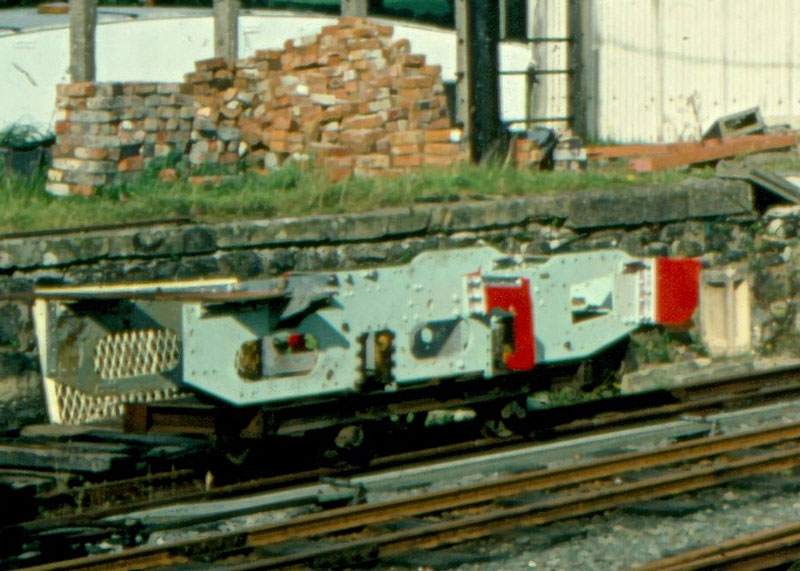
In 1987 Chris Scott, a volunteer at the Bala Lake Railway purchased all the components of "Alice" and, with the guidance and technical help from long term friend David Black (who had become Engineer at Llanuwchllyn in 1984 on the retirement of George Barnes), Chris set about the restoration of the engine at Llanuwchllyn.
At this stage "Alice" consisted of frames, tank, rods, brasses and cylinders. The remains of the cab existed and Alan Cliff presented the new owner with a coffee table - made from the original cab side of "Holy War" - in the hope it could be reused. Some parts of the motion remained although axle boxes and brasses appeared to be missing.
Many hours were spent scraping away the layers of rust and scale from the frames until the missing buffer beam could be fitted.
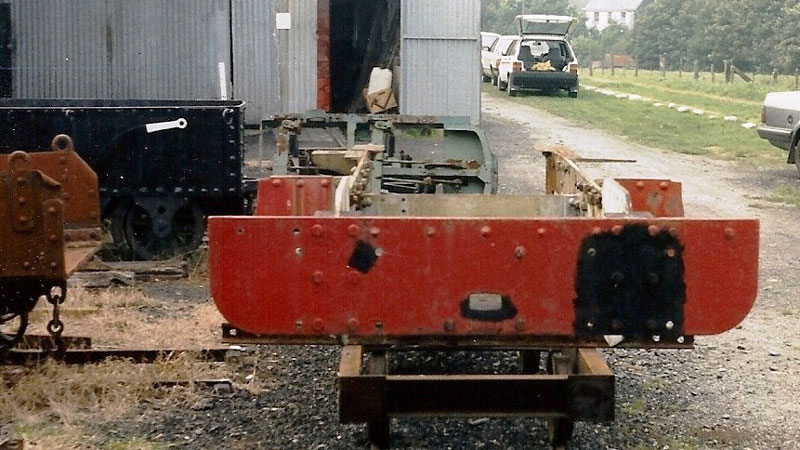
An unusual set of axleboxes and brasses were found on a shelf at Tywyn Pendre Works (Tallyllyn Railway). Moreover outside the works was a set of wheels which had apparently come from Bala. These were all found to be from "Alice", three of the axle boxes carrying the number 780, although the fourth was from "Velinhelli" (409 of 1886).
During the winter of 1987/1988 the wheels were taken into the works, reprofiled and pressed out to 1ft 11 5/8in. from the original 1ft 10 ¾ in. Although at this stage there was no boiler to put them in, new tubes were purchased on a trip to Scotland where a fellow enthusiast was retubing his standard gauge locomotive, but had ordered the tubes two inches too short.
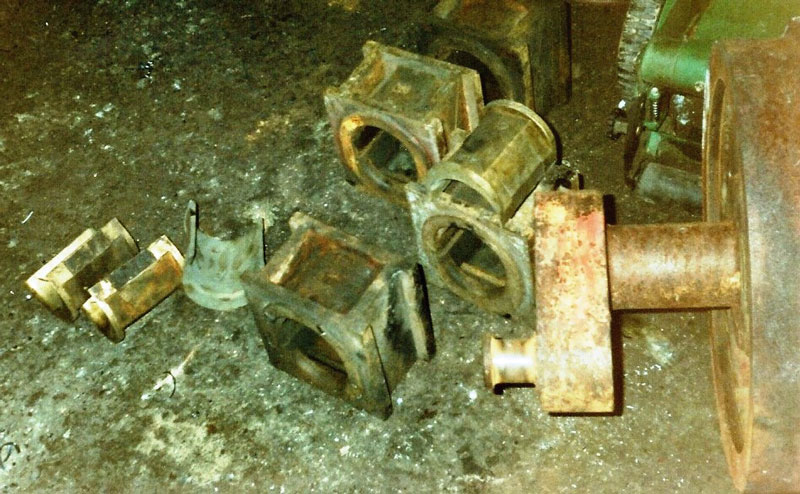
Axle boxes found at the Tallyllyn Railway Nov 1987. Photo: Chris Scott
New hornblocks were made, machined and fitted to the frames and it was decided to re slipper the badly worn axleboxes. Springs and buckles were ordered and by July 1988 the wheels and axleboxes had been refitted. In August of that year "Alice" was rolled out of the workshop and with a coat of red oxide, one running plate and a hurriedly fitted cabside, and appeared in a Bala Lake Railway Gala.
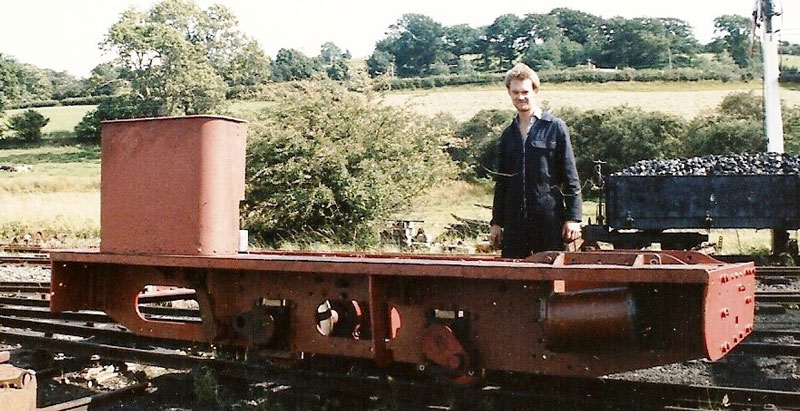
David Black with Alice at the BLR gala August 1988 Photo: Chris Scott
By now, volunteer Alice Hyde had set up a second hand bookstall on the platform at Llanuwchllyn and the proceeds together with a collecting box on the frames, helped raise funds for the restoration.
Work on the Bala line during 1988 slowed progress, and it was not until April 1989 that work on the springs and hangers restarted. An old school in the owner’s home village now housed Scanwell Engineering, a small works specialising in precision control mechanisms for hospitals and laboratories, but which undertook profile cutting the brake hangers for the locomotive.
Four large pieces had previously been cut away from the sides of the old water tank, which was not the one fitted when "Alice" was brought down from the quarry and is apparently the tank taken from "Irish Mail". Since it was of the original riveted design, the decision was taken to try and save it. Advice was sought from Derek Crump of C.C. Crump (Wagon Repairers) of Deeside, Clwyd. Skilled welding in difficult circumstances near very thin old metal resulted in a successful repair in 1989.
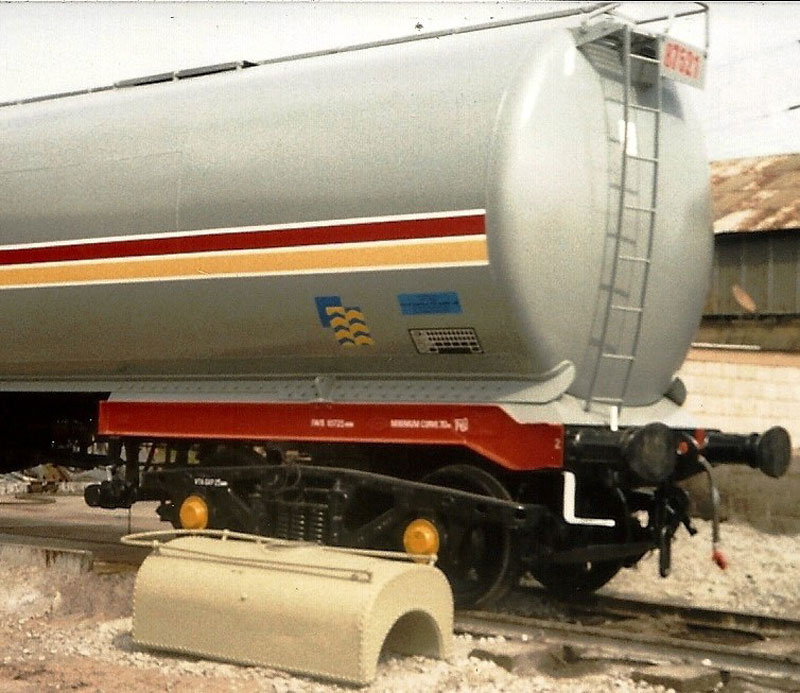
Alice’s tank at C.C.Crump showing the largest and smallest jobs being carried out that week!
Photo: Chris Scott
The remainder of 1989 saw work on the brake rodding and milling of the spring hanger brackets and, to provide a diversion, the two cylinder bores were honed and the slide bars ground. The latter work was carried out at Dolgellau College of Further Education by David Black, who lectured there on Engineering and Design in addition to his duties at Bala. To round off that year, Hunslet supplied a set of works plates of the raised letter type which were accurate for the locomotive - thus "Alice" has genuine replica plates! It transpired that the original worksplates, long separated from the locomotive, did still exist - more about this later.
New steel was obtained for the running plates and a new set of valve buckles made at a small industrial forge in Flint a pair was also obtained for "Holy War" at the same time. Another co-operative effort was the casting of a set of steam pipes by the Rhuddlan Foundry. Fortunately the Maid Marian Society had the patterns and the relevant core boxes, and in 1994 a duplicate set went to Alastair Lamberton for his Hunslet "Margaret".
The National Slate Museum at Llanberis, in the old Gilfach Ddu works, cast replica brass name plates in its foundry. The wooden patterns for the piston glands were cast in bronze from the same source - once again these workshops produced parts for one of ‘its’ engines.
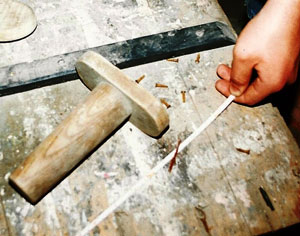
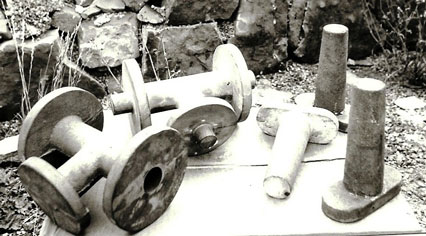
Pattern for piston gland. Photos: Chris Scott
At the end of 1990 "Alice" had to be moved from Bala Lake Railway to a garage near the owner’s home. The departure was effective if undignified! A chain was attached to each corner of the rolling chassis which was lifted onto a skip lorry. The rear wheels went to Winson Engineering for new crank pins to be fitted, and the original handbrake was discovered at the West Lancashire Railway and purchased.
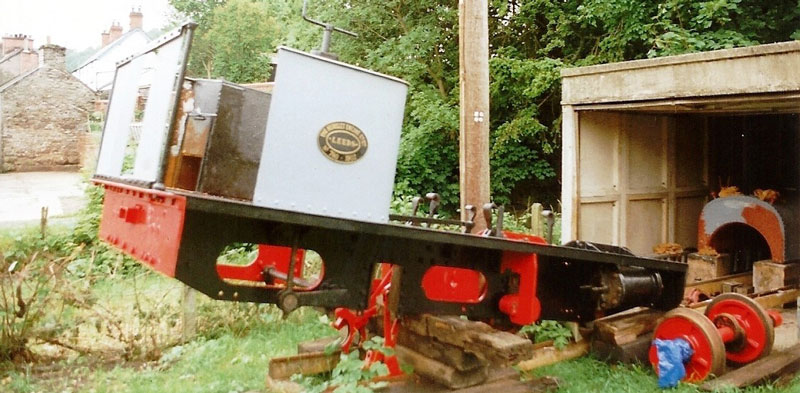
On the move again to the owner’s garage. Photo: Chris Scott
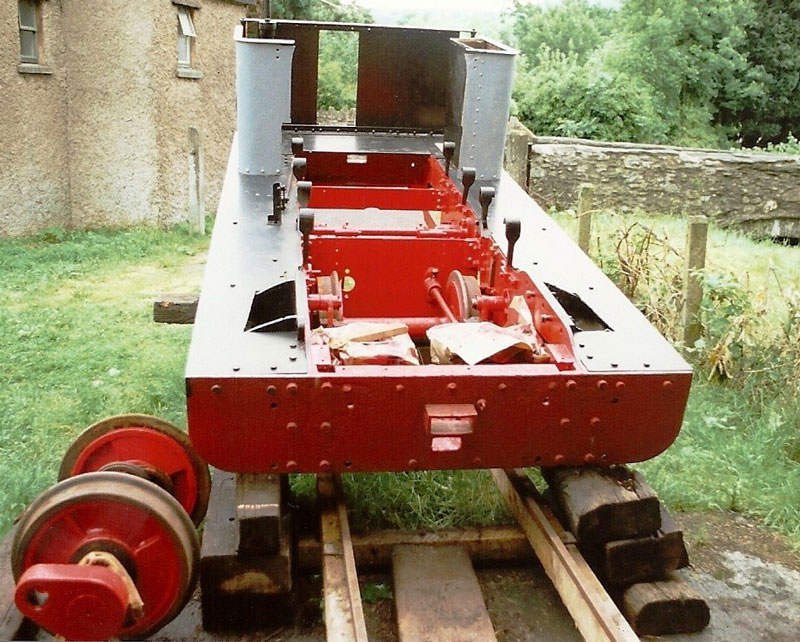
The question of the boiler remained unresolved. Conversations with people at the Leighton Buzzard Railway resulted in agreement that their railway would finance the construction of a new boiler by Bennet’s Boilers of Bristol; in return, "Alice" would go to Leighton Buzzard for five years.
Work on the boiler commenced in June 1991 with the purchase of the boiler plate – the barrel is an off cut piece of North Sea gas/oil pipeline purchased from Holland! The 40 lengths of 12ft tubes which had been in store were transported from North Wales to Bristol where the boiler and firebox were under construction.
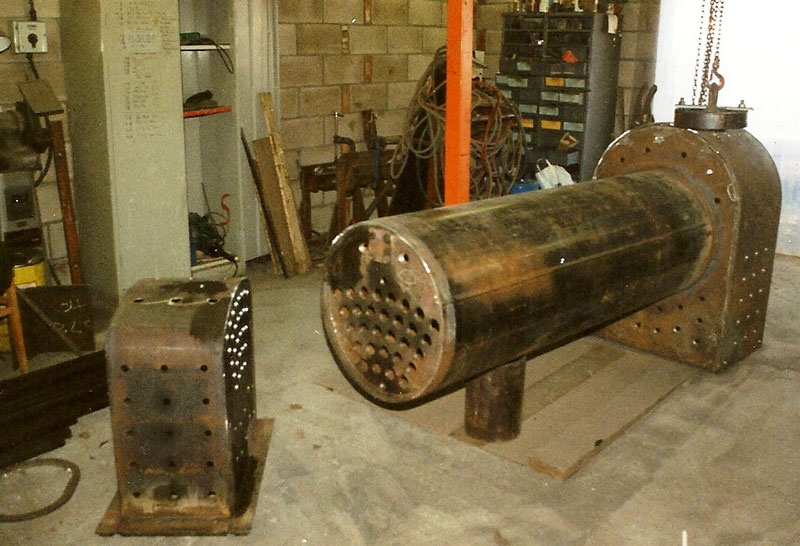
Photo: Chris Scott
In the meantime the cylinders had been taken to Coleg Meironydd in Dolgellau where David and Chris surface milled the valve ports and faces. On return these were reunited with the frames, the fitted bolts having been machined at Bala.
The new boiler was successfully hydraulically tested and certified and while delivery was eagerly anticipated, a potential problem was also apparent. If the boiler was delivered to Chris’ lock up garage ‘loco shed’ it would be impossible to extricate "Alice" by the same method by which she had arrived, ie by skip lorry. Scanwell Engineering agreed that the rolling chassis could stand in their yard, the move being achieved in late November 1991 by a large Massey Ferguson tractor towing the small, partially complete, Quarry Hunslet through the village - the road still bears the marks of "Alice"’s wheels.

Moving through the village Nov. 1991. Photo: Chris Scott
The boiler/firebox arrived on 9th February 1992 and was lifted with the front forks of a JCB which inched forward and lowered the new assembly to fit snugly into place supported by a couple of sleepers.
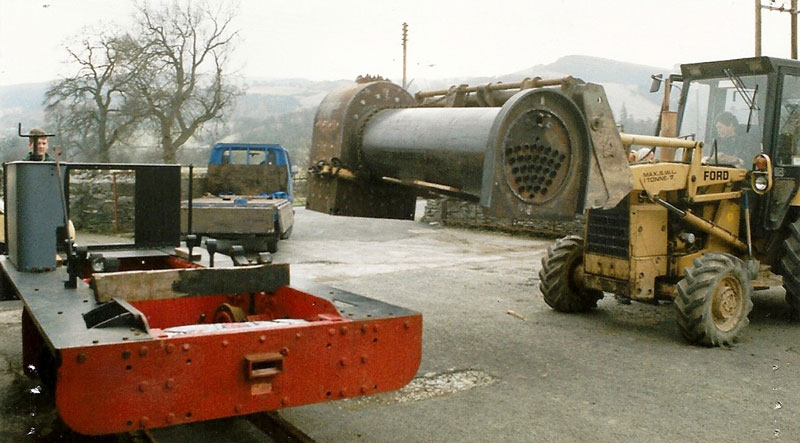

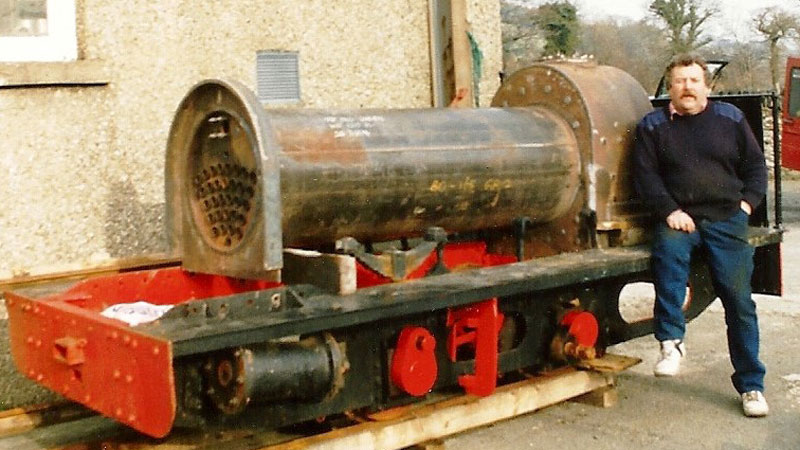
Photos: Chris Scott
Scanwell Engineering built a new smokebox utilising the original door which had been included in the original ‘kit of parts’.
Meanwhile work proceeded on the cylinders, valve chests and fitting the newly machined valves, valve straps and glands. A pattern was found in the collection at Gilfach Ddu for a regulator assembly and steam pipes and the castings were made by Colin Roberts at the Rhuddlan Foundary.
David Black had machined the steampipes, Scanwell had completed the smokebox and Chris had finished painting the boiler barrel and got the lagging in place. Fixing brackets were made and the tank was located between the smokebox and the cab sides.

Fitting the tank. Photo: Chris Scott
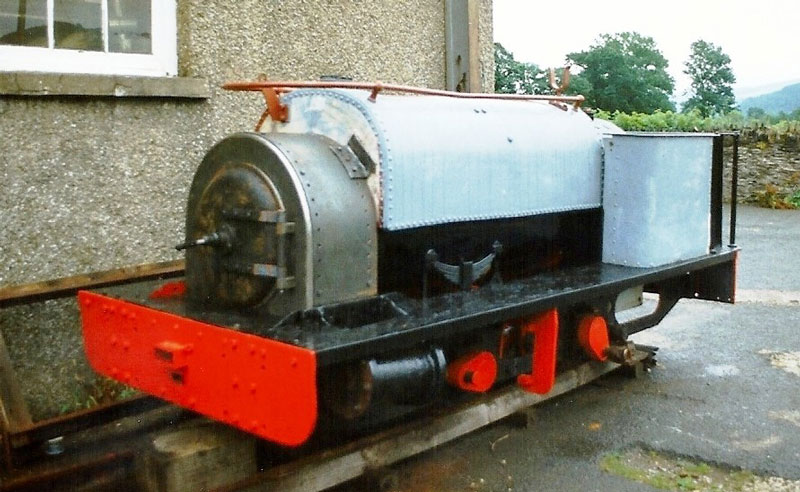
Smoke box done. Photo: Chris Scott
As the locomotive took shape and increasingly valuable fittings added, a more secure location was required. An offer of covered storage for "Alice", and available workshop space, was made at the Ffestiniog Railway works at Boston Lodge. On 30th October 1992 Alice left Scanwell’s at a 45 degree angle on a flatbed lorry.
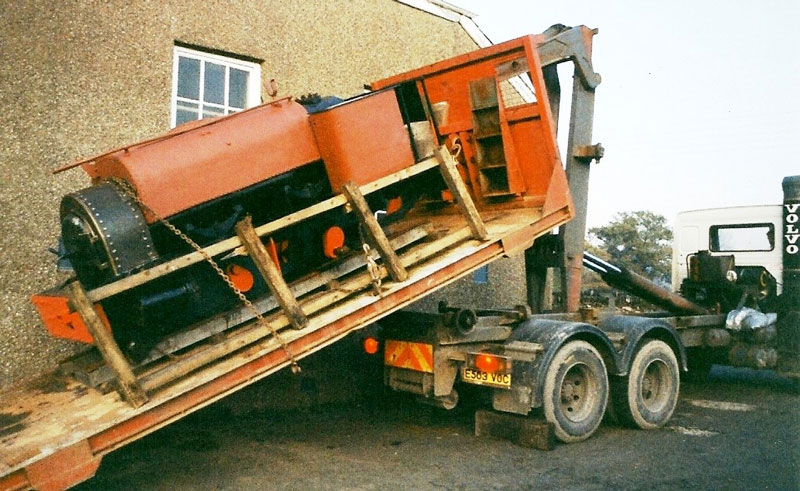
Photo: Chris Scott
Within minutes of arriving at Portmadoc "Alice" was sitting on Ffestinog metals. After the last train of the day had passed she was moved over to the works yard and put at the back of the shed alongside "Britomart".
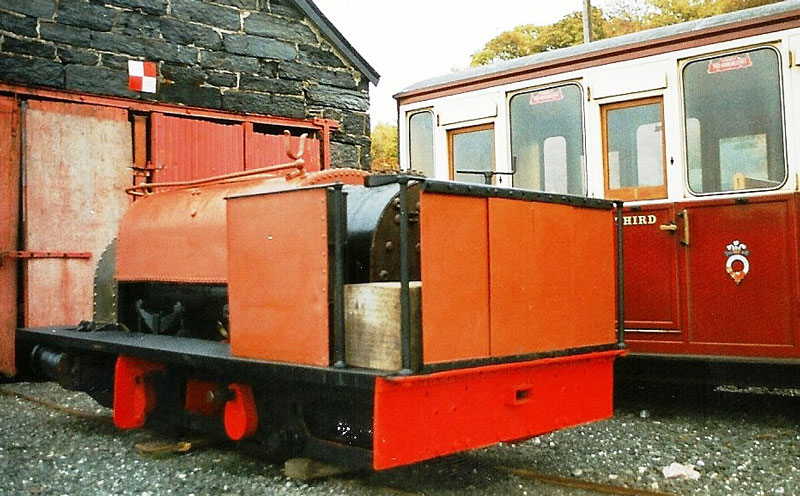
Arrival at the FR 1st Nov 1992. Photo: Chris Scott
By December David, who had now become employed by Boston Lodge had started work white metalling the axle box brasses. This was a method he had employed at Bala and resulted in much smoother running. The white metal was supplied and poured by Tywyn Pendre Works and by the beginning of 1993 the axle boxes had been machined and fitted, the wheelsets reassembled and the keeps fitted. The inside motion, which had all been rebushed and re pinned, was also reassembled. The riveted water tank was finished off in time for "Alice" to make an appearance at the FR Hunslet 100 Gala in May 1993.
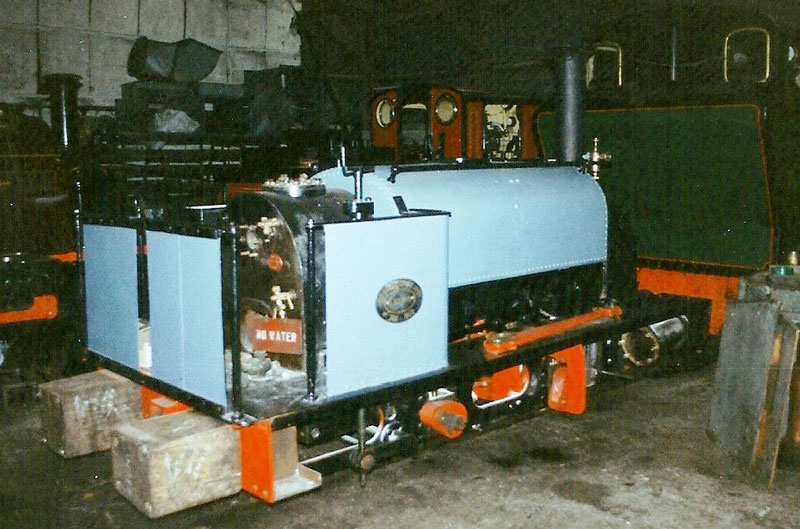
May 1993. Photo: Chris Scott
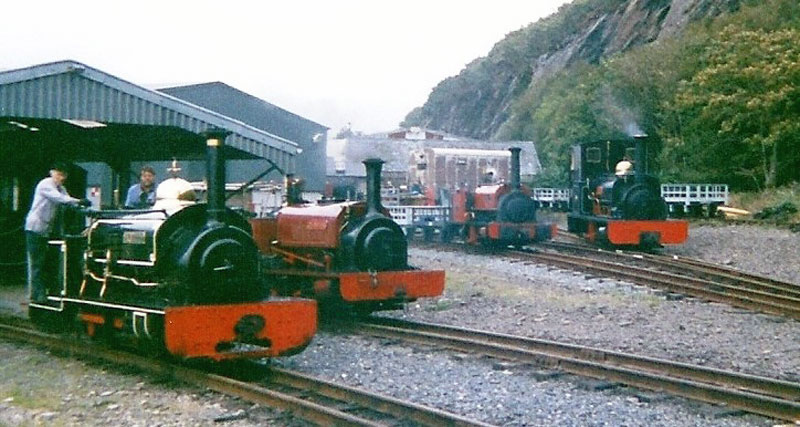
Hunslet 100 Gala May 1993. Photo: Chris Scott
It was at this gala that Alice was reunited with one of her original name plates after a period apart of 25-30 years.
A Penrhyn chimney top had been obtained and was turned to resemble a Dinorwic pattern but the base proved more of a problem. A mock up was made by inverting the Dinorwic style top and doctoring it with body filler. Using this as a pattern, Rhuddlan Foundry produced a casting. Another potential stumbling block was the manifold which sits on top of raised steam chamber and houses the safety valves, whistle and other steam take offs. The original casting in phosphor bronze was in one piece and incorporated the two safety valves. To have one recast and machined would have been expensive as would fabrication in modern metals. The decision was therefore taken to construct a fabricated design into which would threaded two ‘off the shelf’ safety valves.
Derek Crump of C.C. Crump at Connah’s Quay designed and built a new manifold and following pressure testing and certification, it was bolted to the engine. Next came the exercise in ‘plumbing’ with the addition of gauge glasses, injectors, clack valves etc.
The 14th August 1993 was to have the largest red letters yet - "Alice" was to be moved into the open and a fire put in her. Steam was slowly raised to 50psi with no apparent problems, everything being steam tight. Steam raising took longer than expected but with the absence of an ashpan and with holes in the smoke box not filled with fire clay, there was no opportunity to create a substantial draught so this was not an undue concern - "Alice" was back in steam.
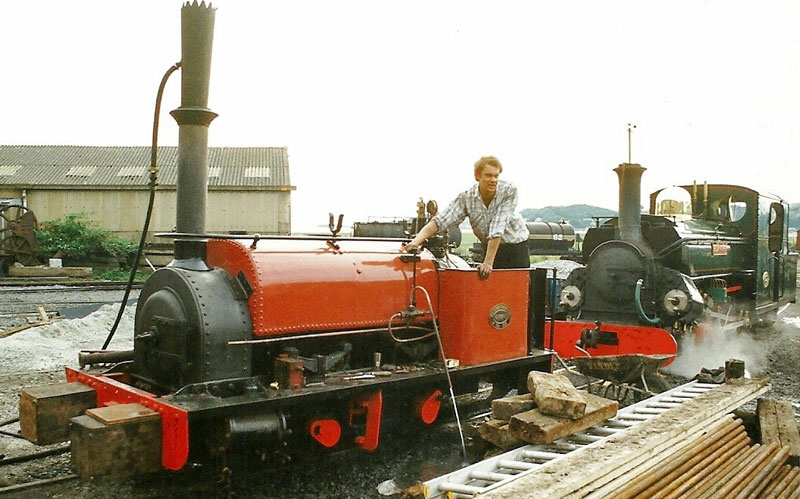
First steam test by David Black 14 August 1993. Photo: Chris Scott
By 28th of that month the odd jobs had been attended to and a second attempt was made to raise steam. This time full pressure was reached and the safety valves lifted correctly, and the whistle (which had been salvaged some years earlier from the Fairbourne Railway) was vigorously blown!

Second steam test August 1993 Photo: Chris Scott
"Alice" still could not propel herself, and the outside motion was next to receive attention. After coupling and connecting rod brasses had been white metalled they were machined, scraped and individually fitted to their respective crank pins. The pistons had come with the original ‘kit of parts’- now it was discovered they were different sizes! David Black then decided the best course of action was to have two new piston heads made, then fit Clupet rings. A pattern was made up, and on the return of the finished casting from the Rhuddlan Foundary, David turned both piston heads on a lathe to fit accurately the cylinder bores. Clupet rings were obtained via the Ravenglass & Eskdale Railway and the pistons fitted. Only one crosshead came with the kit and a second was cast at Rhuddlan Foundary. The method of creating the pattern was the same as for other parts which had required casting. The existing part was ‘enlarged’ by the addition of plywood veneers and plastic padding to allow for shrinkage during casting, and to provide surplus metal for later machining down. The crossheads were completed, the crosshead slippers also being white metalled and machined to fit the newly machined slide bars.
The winter of 1993/94 was largely spent on assembly work, with a further steam test in late January. The next stage was to deal with lubrication and various fittings. A mechanical lubricator was fitted to feed oil into the steam chest and axleboxes were added to the footplate to supply the axleboxes. The regulator was fitted, the handle bearing No.679 "Covertcoat", and attention was given to the reverser. Early on in the project Chris had spotted an LSWR point lever in the scrap pile at the Talyllyn’s Pendre Works and purchased it as a possible solution to the reverser problem. This was slimmed down to a suitable size- fortunately "Britomart" was handy to provide the correct pattern and measurements. With the addition of a newly machined quadrant the reverser assembly was complete. By now "Alice" was rubbed down to receive her paint, the spraying to be done by Seamus Rogers at Boston Lodge. The paint used was the remainder of an experimental batch mixed for the Double Fairle "David Lloyd George".
The day everybody had been waiting for came on 1st May 1994. Steam was raised, then David Black gently eased over the regulator, and "Alice" moved again for the first time in nearly 30 years under her own power. The following weeks saw the ashpan completed by Steve Jones (resident fabricator/welder at Boston Lodge), further adjustments to the drain cocks and linkages, and the locomotive was regularly steamed to ‘just run her in’!
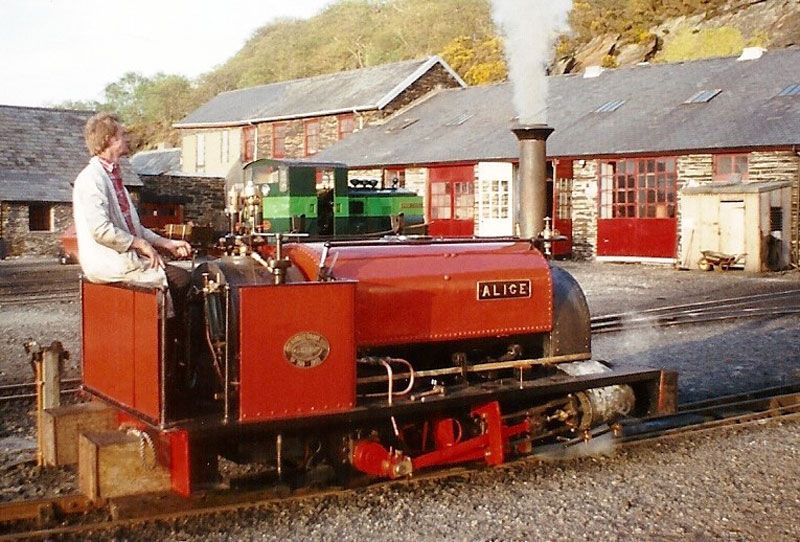
Permission was obtained to take "Alice" out onto the main line at the end of the normal day’s services one day in May, Chris, David and Colin Dukes (as ‘pilotman’) took "Alice" out over the cob to Portmadog Harbour station. After oiling round they set off back over the cob and continued up to Minffordd. After oiling round again and checking for hot boxes the engine set off for Penrhyndeudraeth, then back to Porthmadog Harbour where an oil tanker wagon was picked up for the return to Boston Lodge. The only defect found was an audible ‘click’- diagnosed as a crosshead slipper on the driver’s side which was subsequently adjusted, along with tweaks to the valve setting.
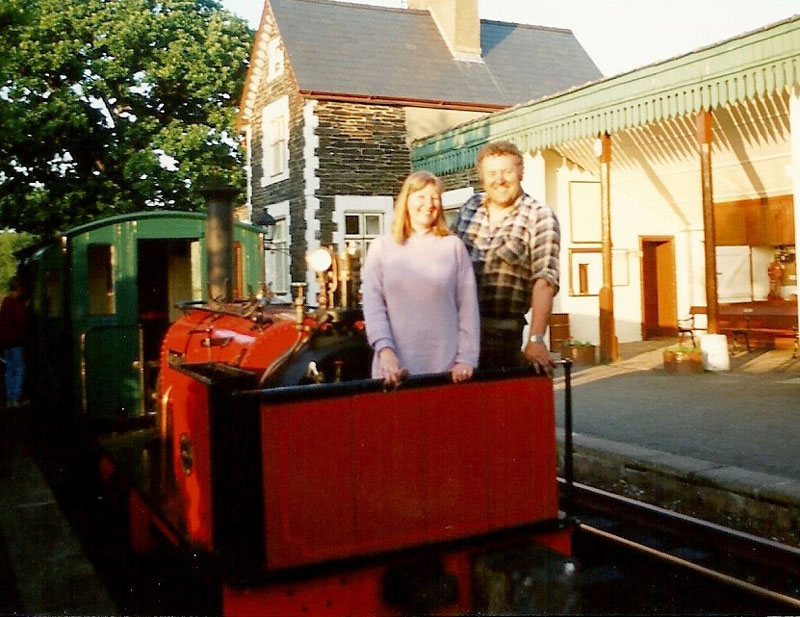
Chris and Margret Scott on one of the early runs. Photo: Chris Scott
The next trip up the line was on 25 May 1994, this time with a bogie coal wagon containing two bench seats. After calling at Minffordd yard, the little train set off for Blaenau.
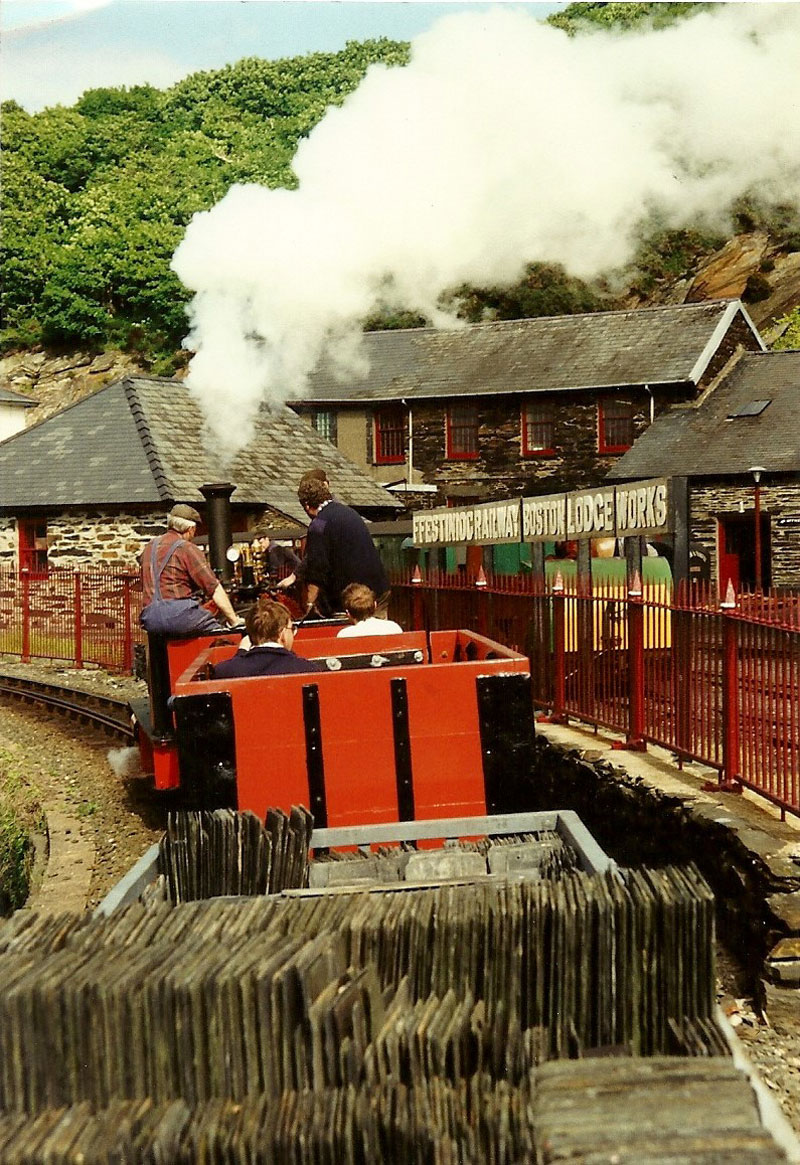
Photo: Chris Scott
After a stop at Rhiw Goch for an oil and check round, "Alice" then made longest run in her existence by reaching Tan-y-Bwlch in just 40 minutes after leaving Penrhyn. As there was more than half a thankful of water and plenty of coal it was decided to continue.
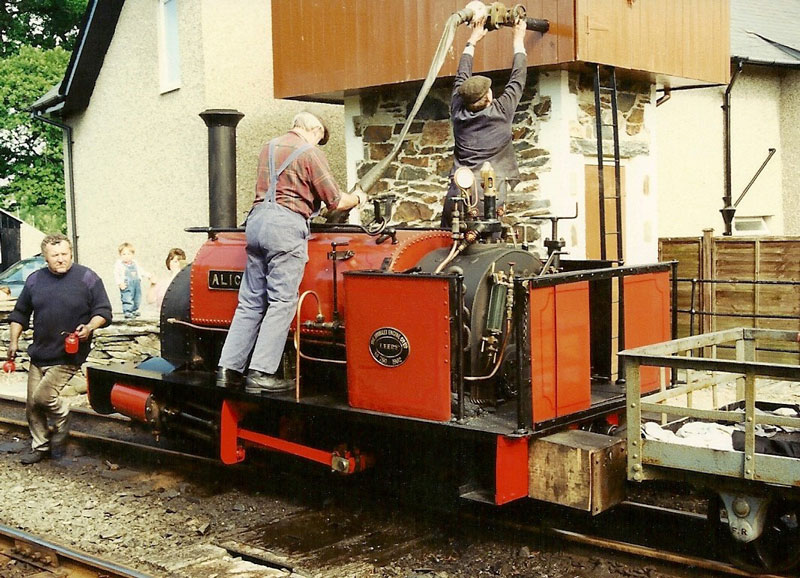
Photo: Chris Scott
There was a brief stop at Ddualt, where some of the party de trained to video the ascent of the spiral, then on through the tunnel, non-stop past Tan-y-Grisiau, and into Blaenau. After running round the wagon, oiling and checking round, the diminutive train set off back to Boston Lodge, arriving a little after 10pm.
The final details in the project were completed, the dumb buffers fitted and the locomotive lined out, and on 13 June 1994 a final run up to Rhiw Goch was made.
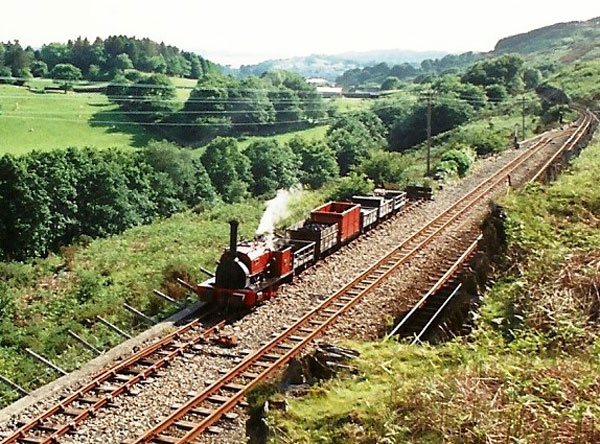
Final run before leaving. Photo: Chris Scott
The next day a transporter arrived at the FR returning "Sgt. Murphy" and "Palmerston" from a gala at the Teifi, where she was joined by "Chaloner" and "Rishra", the trio then departing for Leighton Buzzard which was reached on the evening of 15th June 1994.
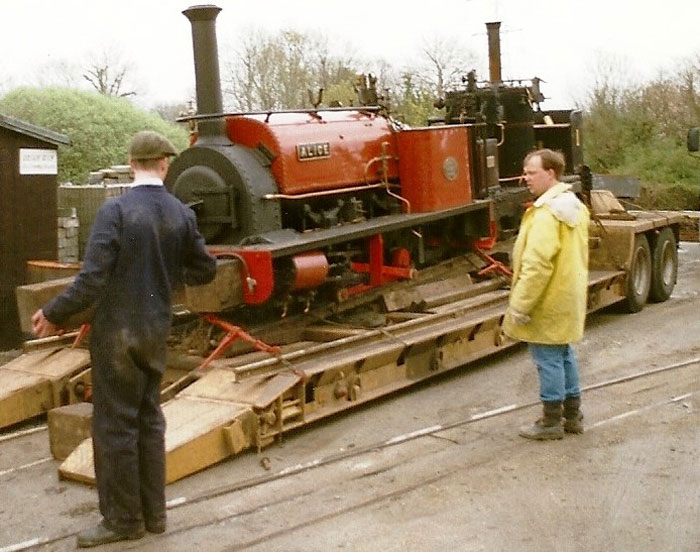
14 June 1994 Leaving for Leighton Buzzard. Photo: Chris Scott
The first trip at Leighton Buzzard was made on 19th June 1994 when she was taken over the length of the line, the only slight problem being the discovery that the road crossing at the Vandyke Road was a little tight to gauge. On Saturday 10th September, 1994 at the Leighton Buzzard Steam Gala, Alice Hyde travelled down to rededicate the name of the locomotive, thus fulfilling the promise made by Chris in appreciation of her efforts to raise funds with the bookstall at Llanuwchllyn. After suitable speeches, Mrs. Hyde poured champagne over the name plate.
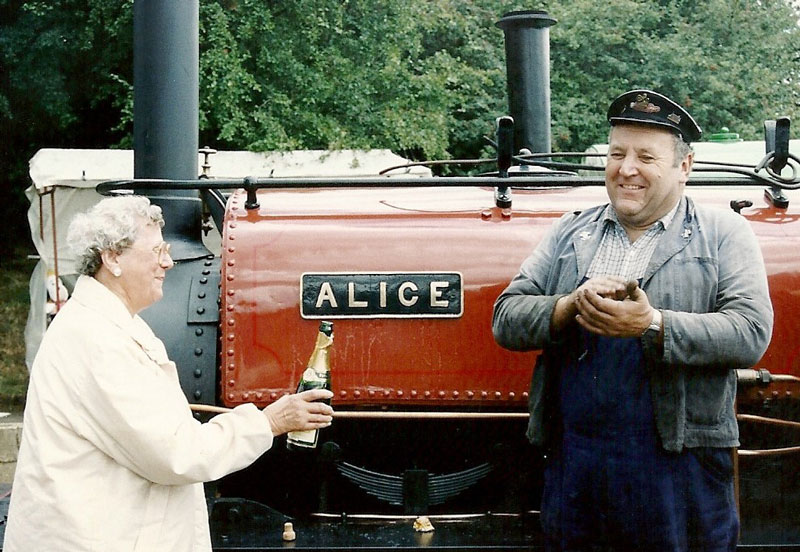
Alice Hyde rededicating Alice's name plate 10th September 1994. Photo: Chris Scott
The following day saw "Alice" working her first passenger trains, double heading with "Doll", and later in the year at a volunteers’ weekend she worked both with "Woto" and "Peter Pan". The double heading was necessary since air braking equipment had not been fitted, this being completed in time for "Alice" to commence the 1996 season, hauling trains single-handed for the first time since she arrived at Leighton Buzzard. A few minor jobs remained, including the cladding of the firebox, but Alice was fully run in and considered part of the Leighton Buzzard main line fleet.

David Black and Chris Scott prepping Alice at Leighton Buzzard. Photo: Chris Scott
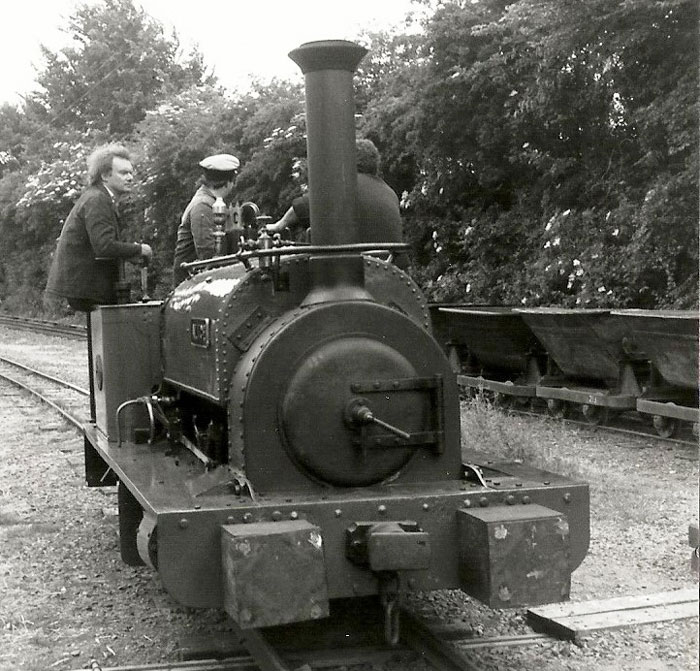
First run on the Leighton buzzard Railway. Photo: Chris Scott

David Black with Alice. Leighton Buzzard. Photo: Chris Scott
"Alice" was not confined to Leighton Buzzard. In 1996 she visited Amberley Chalk Pits Museum where she ran on a short demonstration track, and in October was due to become the first preserved Hunslet to travel abroad, being booked to appear at the October Maldegem Stoom Centrum (Steam Gala) in Belgium. Unfortunately, a problem developed in traffic on 29th September 1996, the day before departure, with four tubes developing leaks at the firebox tubeplate. The tubes were expanded as soon as "Alice" had cooled down, but too late for loading on the transporter. "Alice" was soon back in service and worked train over the weekend of 5/6 October.
In May 1997, "Alice" returned to the FR for the ‘Festival of Steam’ gala, held between 3rd-5th May. Her duties included working a shuttle of semi-open coaches between Minffordd station and yard.
On 6th May a special double headed evening train was organised. Departing Boston Lodge at 5.30 "Alice" and "Velinheli" took a train consisting of a slate wagon (loaded with a barrel of water and pump in case additional supplies were needed), a Hudson bogie open wagon and brake third no 10. A small group of guest passengers rode in the open wagon, despite the cold conditions and occasional rain, others opted for the shelter of the coach! After a stop at Minfford to take water and cross the down service train the ‘Hunslet Express’ set off on an epic, non stop run to Blaenau and this was achieved in just 49 minutes - faster than the service schedule. The footplate crew were James Evans and Paul Lewin of the FR. The return run was also accomplished without problem and these small locomotives proved once again that they are perfectly capable of sustained running at reasonable speeds. As night fell the trip came to a happy conclusion with the Locos arriving back at Boston Lodge.

Alice subsequently returned to Leighton Buzzard.
The second return visit of significance came in mid 1999 when the opportunity for "Alice" to go back to the Bala Lake Railway arose. A major gala to celebrate the 25th anniversary of the Bala Lake Railway Society (a year late!) was organised with invitations extended to Leighton Buzzard –based locos and 0-4-0VTB deWinton, "Chaloner". The pair were duly taken to Llanuwchllyn and over 14th/15th August event "Alice" ran over the Bala Lake Line for the first time – her appearance at the Railway actually being the first time she had been in complete condition at the line where her restoration started.
In 2000, the opportunity to make up for the disappointment of the cancelled trip to Maldegem arose and "Alice", together with de Winton 0-4-0 VTB, "Chaloner", went to Germany for the 25th anniversary festival of the Feldbahnmuseum in Frankfurt between 1st-4th June.
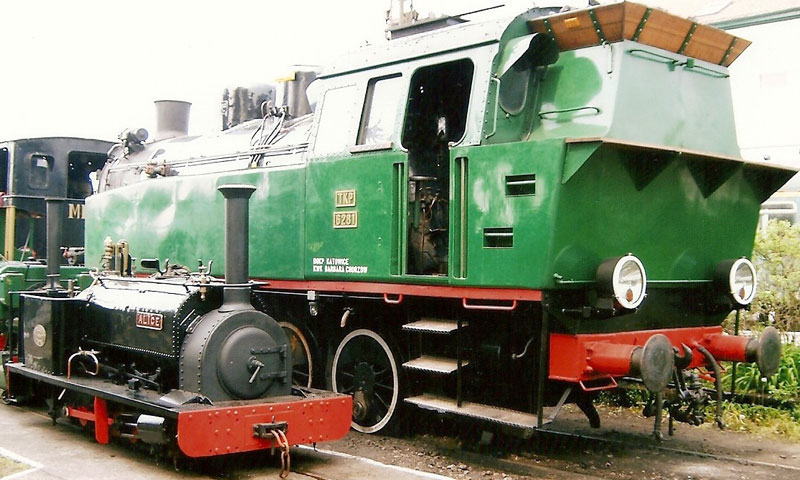
Feldbahn Museum, Germany. Photo: Chris Scott
On the 7th/ 8th October 2000 "Alice" revisited the Ffestiniog Railway for their Vintage Weekend, during which she participated, with other Hunslet visitors in the ‘Grand Slate Shunt’ in Minfford Yard.
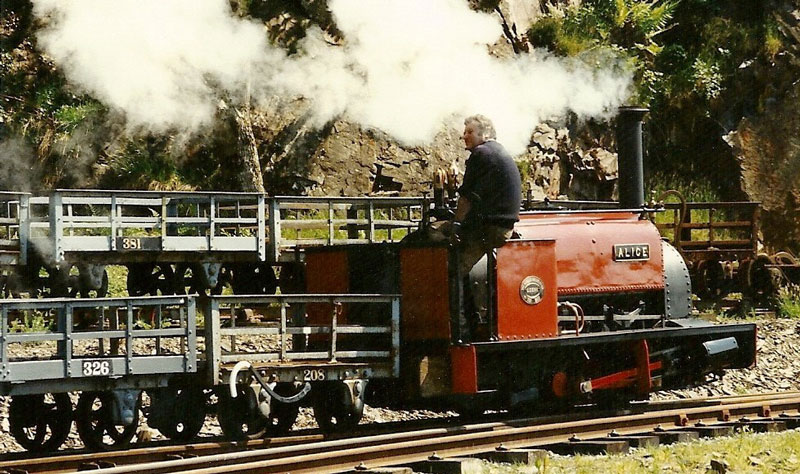
Grand Slate Shunt. Photo: Chris Scott
The Original agreement was extended and she remained at Leighton Buzzard until hauling her final LBR train on 26th October 2003. "Alice" then returned to the Bala Lake Railway where her restoration first commenced – and received a new black livery to start a new era.
In late 2009 it was time for Alice to have her ten year overhaul and Chris decided that once completed it was time to pass on the responsibility to someone else. Julian Birley who had completed fallen under the spell of these delightful little engines became aware of the opportunity and on meeting Chris in November 2009 agreed to take on that responsibility the following year.
Her overhaul included retyring, retubing and a general strip down. Julian was keen to carry on the task that Chris has so ably started and that was returning her to as close to original condition as possible.
The most common topic of conversation with any locomotive is the livery and while there was no definite record as to how these engines were turned out in the quarry and it was hard to determine the colour from old colour photographs it was decided to get a number of samples and invite people who knew the locos during the working life in the quarry to come down and give their opinion. Therefore the livery she carries today is that chosen by the quarrymen.
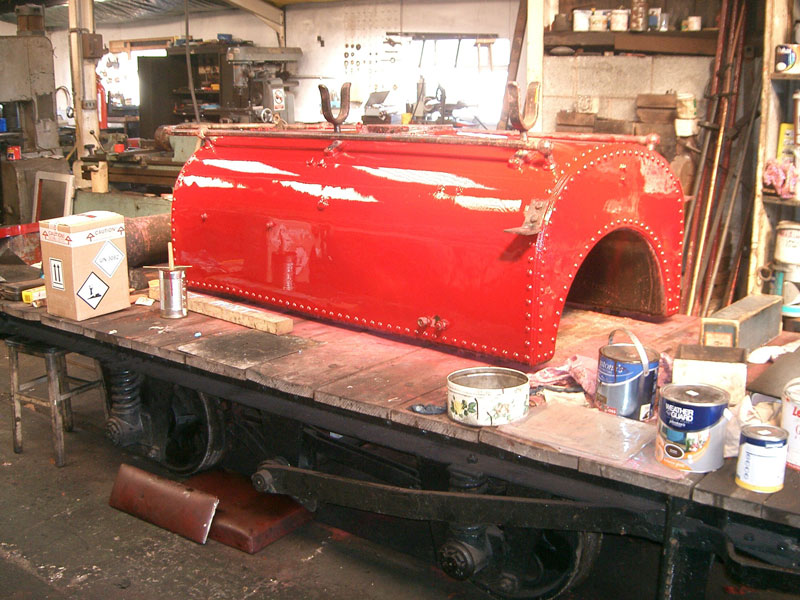
New Livery. Photo: Julian Birley

Rob Houghton CME Bala Lake Railway, Chris Scott previous owner and Julian Birley new owner. 2010
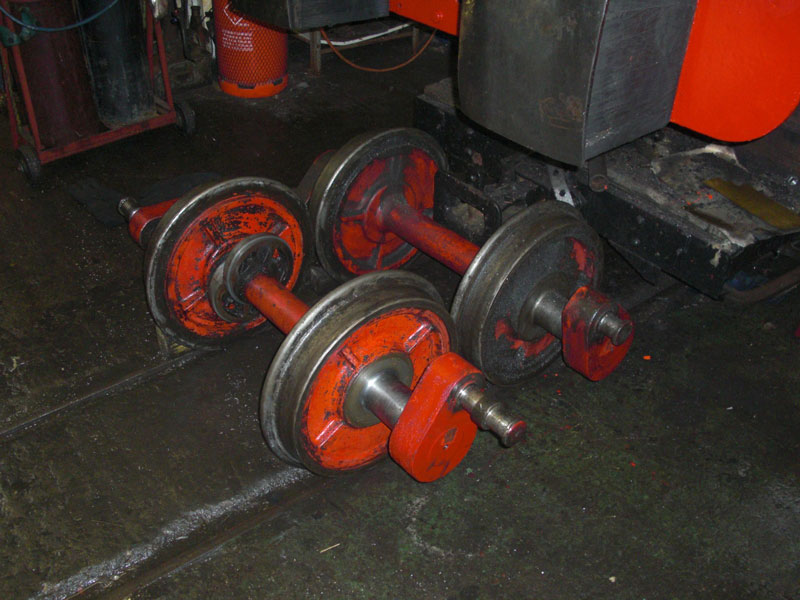
Wheels waiting to go for retyring
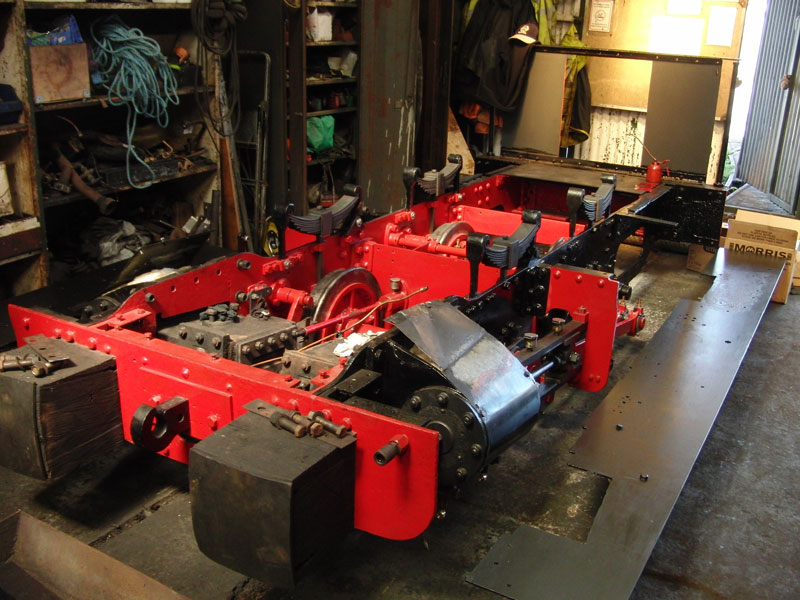
Frames under overhaul

July 2010 looking immaculate!!


